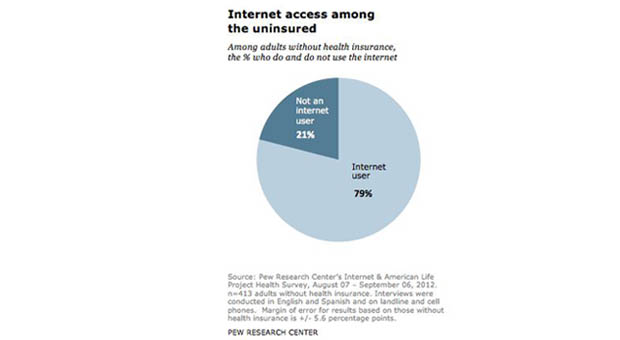Image Credit: Pew Research Center
On October 1, 2013, open enrollment began under the Affordable Care Act (ACA), and approximately 2.8 million Americans visited Healthcare.gov to compare and apply for health coverage. For many, the online portal is the easiest and quickest way to accomplish these tasks and find related resources. Unfortunately, this option is not a viable one for the 15 percent of American adults who don’t use the internet for various reasons, as discussed in one of our recent Weekly Number posts. Furthermore, the Pew Research Center recently found that about 1 in 5 (21%) uninsured Americans don’t use the internet.
Forever devoted to the principle of equitable access, libraries are integral in ensuring that these offline parties are not denied the opportunity to obtain affordable health coverage. Those who do not use the internet due to lack of access will find it offered for free at the library, and those experiencing difficulty in navigating the internet might benefit from library programs aimed at teaching basic technology skills. Additionally, libraries across the country have taken special efforts to disseminate information about the ACA, and help interested parties obtain coverage. In Colorado, for example, interested parties can find a list of library presentations on the ACA throughout the state—and elsewhere—via the Connect for Health Colorado portal, or via individual libraries’ websites (e.g., the Denver Public Library’s “Affordable Care Act” page). At other libraries, such as the Waukegan Public Library in Illinois, patrons can “drop in” for bilingual group or one-on-one sessions with library staff to determine their eligibility for certain plans, compare prices, and apply for coverage. The passage of the ACA has afforded libraries another opportunity to demonstrate that they are receptive and responsive toward community needs, and they are surely up to the task.
Additional resources:
- ALA’s “Libraries and the Affordable Care Act” page: See whether, and how, the professional library organization in your state is helping libraries to disseminate information about the ACA.
- WebJunction’s free webinars on the ACA.
Note: This post is part of our series, “The Weekly Number.” In this series, we highlight statistics that help tell the story of the 21st century library.
